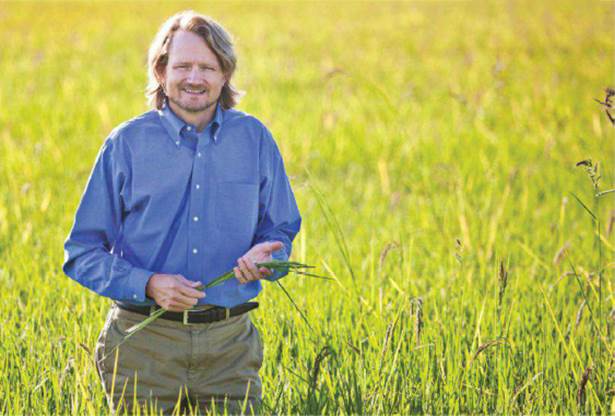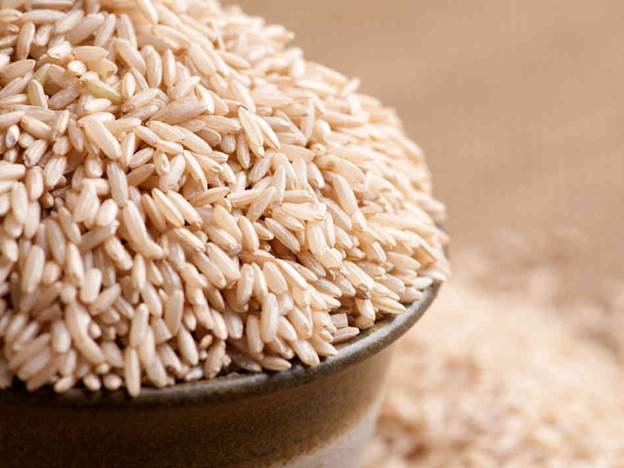The USA Rice Federation tells consumers
that there is no reason to be concerned about arsenic in food. Its website
states that arsenic is “a naturally occurring element in soil and water” and
“all plants take up arsenic”.

Grant
Lundberg, a rice producer in Richvale, Calif, has begun extensive testing for
arsenic.
But “natural” does not equal safe.
Inorganic, the predominant form of arsenic in most of the 65 rice products we
analyzed is ranked by the International Agency for Research on Cancer (IARC) as
one of more than 100 substances that are Group 1 carcinogens. It is known to
cause bladder, lung, and skin cancer in humans, with the liver, kidney, and
prostate now considered potential targets of arsenic-induced cancers.
Though arsenic can enter soil or water due
to weathering of arsenic-containing minerals in the earth, humans are more to
blame than Mother Nature for arsenic contamination in the U.S. today, according
to the federal Agency for Toxic Substances and Disease Registry. The U.S. is
the world’s leading user of arsenic, and since 1910 about 1.6 million tons have
been used for agricultural and industrial purposes, about half of it only since
the mid-1960s. Residues from the decades of use of lead-arsenate insecticides
linger in agricultural soil today, even though their use was banned in the
1980s. Other arsenical ingredients in animal feed to prevent disease and
promote growth are still permitted. Moreover, fertilizer made from poultry waste
can contaminate crops with inorganic arsenic.
Rice is not the only source of arsenic in
food. A 2009-10 study from the EPA estimated that rice contributes 17 percent
of dietary exposure to inorganic arsenic, which would put it in third place,
behind fruits and fruit juices at 18 percent, and vegetables at 24 percent. A
more complete study by the European Food Safety Authority found cereal products
could account for more than half of dietary exposure to inorganic arsenic,
mainly because of rice.

“Extensive
surveys of south central U.S. rice, by more than one research group have
consistently shown that rice from this region is elevated in inorganic arsenic
compared to other rice-producing regions,”
Rice absorbs arsenic from soil or water
much more effectively than most plants. That’s in part because it is one of the
only major crops grown in water-flooded conditions, which allow arsenic to be
more easily taken up by its roots and stored in the grains. In the U.S. as of
2010, about 15 percent of rice acreage was in California, 49 percent in
Arkansas, and the remainder in Louisiana, Mississippi, Missouri, and Texas.
That south-central region of the country has a long history of producing
cotton, a crop that was heavily treated with arsenical pesticides for decades
in part to combat the boll weevil beetle.
“Extensive surveys of south central U.S.
rice, by more than one research group have consistently shown that rice from
this region is elevated in inorganic arsenic compared to other rice-producing
regions,” says Andrew Meharg, professor of biogeochemistry at the University of
Aberdeen in Scotland and co-author of the book “Arsenic & Rice”. “And it
does not matter relative to risk whether that arsenic comes from pesticides or
is naturally occurring”. High levels of arsenic in soil can actually reduce
rice yield, notes the Department of Agriculture has invested in research to
breed types of rice that can withstand arsenic. That may help explain the
relatively high levels of arsenic found in rice from the region, though other
factors such as climate or geology may also play a role.
What our tests found
Within brands, brown rice had higher arsenic
than white
We tested 223 samples of various rice
products that we bought mostly in April and May, many from stores in the New
York metropolitan area and online retailers. The samples covered a variety of
rice-containing food categories, including infant cereals, hot cereals,
ready-to-eat cereals, rice cakes, and rice crackers. We bought products often
used by people on gluten-free or other special diets, including rice pasta,
rice flour, and rice drinks.

Within brands, brown rice had higher arsenic than
white
We tested at least three samples of the
foods and beverages for total arsenic. We measured specific levels of inorganic
arsenic. And we checked for two forms of organic arsenic, called DMA and MMA.
Though inorganic arsenic is considered the
most toxic, concerns have been raised about potential health risks posed by
those two organic forms, which the International Agency for Research on Cancer
has labeled “possibly carcinogenic to humans”. We found DMA in the 32 rices we
tested which include choices from the south central states and elsewhere,
including California, India, and Thailand.
In brands for which we tested both a white
and a brown rice, the average total and inorganic arsenic levels were higher in
the brown rice than in the white rice of the same brand in all cases. Among all
tested rice, the highest levels of inorganic arsenic per serving were found in
some samples of Martin Long Grain Brown rice, followed by Della Basmati Brown,
Carolina Whole Grain Brown, Jazzmen Louisiana Aromatic Brown, and Whole Foods’
365 Everyday Value Long Grain Brown. But we also found samples of brown rice
from Martin and others with inorganic arsenic levels lower than that in some
white rice.
Though brown rice has nutritional
advantages over white rice, it is not surprising that it might have higher
levels of arsenic, which concentrates in the outer layers of a grain. The
process of polishing rice to produce white rice removes those surface layers,
slightly reducing the total arsenic and inorganic arsenic in the grain.
In brown rice, only the hull is removed.
Arsenic concentrations found in the bran that is removed during the milling
process to produce white rice can be 10 to 20 times higher than levels found in
bulk rice grain.
We also tested for lead and cadmium, other
metals that can taint food. The levels we found were generally low overall.
Based on our recommended limits for rice products, even the few samples with
elevated lead cadmium should not contribute significantly to dietary exposure.
Cereals cause concern.
Worrisome arsenic levels were detected in
infant cereals, typically consumed between 4 and 12 month of age.
Among the four infant cereals tested, we
found varying levels of arsenic, even in the same brand. Gerber SmartNourish
Organic Brown Rice cereal had one sample with the highest level of total
arsenic in the category at 329 ppb, and another sample had the lowest total
level in this category at 97.7 ppb. It had 0.8 to 1.3 micrograms of inorganic
arsenic per serving.
Earth’s Best Organic Whole Grain Rice
cereal had total arsenic levels ranging from 149 ppb to 274 ppb, but higher
levels of inorganic arsenic per serving, from 1.7 to 2.7 micrograms.
So what’s a parent to do? To reduce arsenic
risks, we recommend that babies eat no more than 1 serving of infant rice
cereal per day on average. And their diets should include cereals made of
wheat, oatmeal, or corn grits, which contain significantly lower levels of
arsenic, according to federal information.

To
reduce arsenic risks, we recommend that babies eat no more than 1 serving of
infant rice cereal per day on average.
The EPA sets limits for a carcinogen based
on how many extra cases of cancer would be caused by exposure to the toxin at a
certain level. The limit is designed to minimize that risk. For our
recommendations, we used the latest available science to choose a moderate
level of protection that balances safety and feasibility, similar to the EPA’s
approach for water. Our scientists made these calculations using standard
estimates of weight, typical daily consumption of individual rice products over
a lifetime, and the range of levels of inorganic arsenic we found. For our
recommendation for children, we paid particular attention to their levels of
consumption during this critical phase of their development.
According to federal data, some infants eat
up to two to three servings of rice cereal a day. Eating rice cereal at that
rate, with the highest level of inorganic arsenic we found in our tests, could
result in a risk of cancer twice our acceptable level.
For children and pregnant women, risks are
heightened. Keeve Nachman, Ph.D., a risk scientist at the Center for a Livable
Future in the Johns Hopkins Bloomberg School of Public Health, says, “The more
we learn about arsenic’s additional effects on the developing brain, the more
concerned I am by these levels of arsenic being found in infant and toddler
rice cereal.”
Ready-to-eat cereals, which are popular
with adults as well as children, also gave us cause for concern. For instance,
Barbara’s Brown Rice Crisps had inorganic arsenic levels that ranged from 5.9
to 6.7 micrograms per serving. Kellogg’s Rice Krispies, at 2.3 to 2.7
micrograms, had the lowest levels for the category in our tests.
Rice drinks in our tests showed inorganic
arsenic levels of up to 4.5 micrograms per serving. Based on those results, our
scientists advise that children under the age of 5 should not have rice drinks
as part of a daily diet. In the United Kingdom, children younger than 41/2
years are advised against having rice milk because of arsenic concerns.
“This is a time when cells are
differentiating into organs and many other important developmental things are
going on, so getting exposed to a toxicant like arsenic in utero or during
early childhood can cause damage that may not appear until decades later,” says
Michael Waalkes, laboratory chief at the Division of the National Toxicology
Program. He is one of the authors of a June 2012 report funded in part by the
National Institutes of Health that concluded early life exposure to arsenic
produces a wide range of cancers and other diseases.